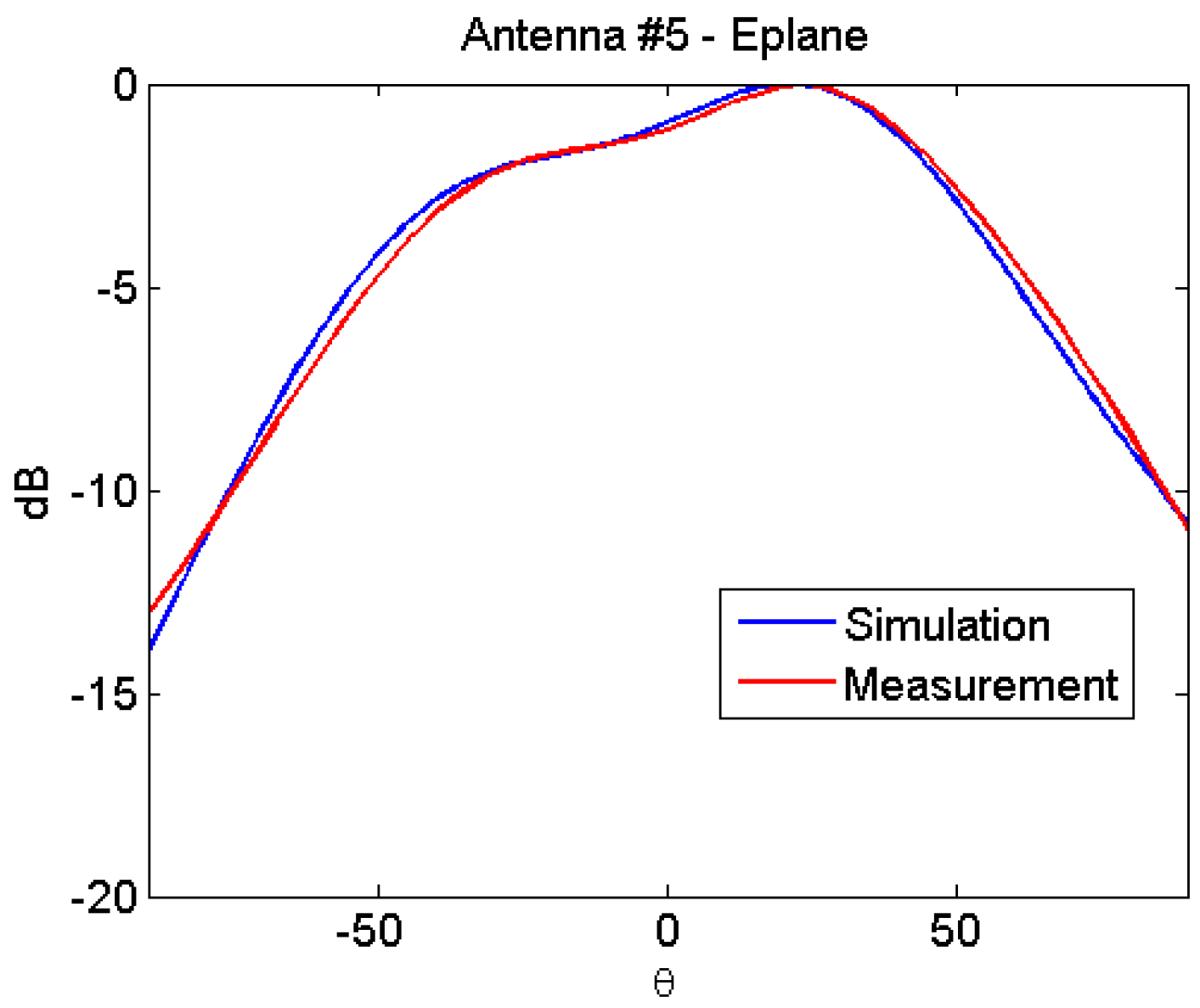Experimental Characterization of a Dual-Polarised Parasitic Patch Antenna
Abstract
:1. Introduction
2. The Antenna Architecture
3. Numerical and Experimental Results
4. Conclusions
Author Contributions
Conflicts of Interest
References
- Paulraj, A.; Nabar, R.; Gore, D. Introduction to Space-Time Wireless Communications; Cambridge University Press: Cambridge, UK, 2003. [Google Scholar]
- Migliore, M.D. On the role of the number of degrees of freedom of the field in MIMO channels. IEEE Trans. Antennas Propag. 2006, 54, 620–628. [Google Scholar] [CrossRef]
- Migliore, M.D.; Pinchera, D.; Massa, A.; Azaro, R.; Schettino, F.; Lizzi, L. An investigation on UWB-MIMO communication systems based on an experimental channel characterization. IEEE Trans. Antennas Propag. 2008, 56, 3081–3083. [Google Scholar] [CrossRef]
- Martini, A.; Massa, A.; Franceschetti, M. Physical limits to the capacity of wide-band Gaussian MIMO channels. IEEE Trans. Wirel. Commun. 2009, 8. [Google Scholar] [CrossRef]
- Pinchera, D. On the limits of MIMO systems: Complete matrix model and intuitive graphic representation. In Proceedings of the 5th European Conference on Antennas and Propagation (EUCAP), Rome, Italy, 11–15 April 2011; IEEE: Piscataway, NJ, USA, 2011; pp. 1248–1252. [Google Scholar]
- Oliveri, G.; Caramanica, F.; Migliore, M.; Massa, A. Synthesis of nonuniform MIMO arrays through combinatorial sets. IEEE Antennas Wirel. Propag. Lett. 2012, 11, 728–731. [Google Scholar] [CrossRef]
- Migliore, M.D.; Pinchera, D.; Schettino, F. A simple and robust adaptive parasitic antenna. IEEE Trans. Antennas Propag. 2005, 53, 3262–3272. [Google Scholar] [CrossRef]
- Donelli, M.; Azaro, R.; Fimognari, L.; Massa, A. A planar electronically reconfigurable Wi-Fi band antenna based on a parasitic microstrip structure. IEEE Antennas Wirel. Propag. Lett. 2007, 6, 623–626. [Google Scholar] [CrossRef]
- Cetiner, B.A.; Akay, E.; Sengul, E.; Ayanoglu, E. A MIMO system with multifunctional reconfigurable antennas. IEEE Antennas Wirel. Propag. Lett. 2006, 5, 463–466. [Google Scholar] [CrossRef]
- Migliore, M.D.; Pinchera, D.; Schettino, F. Improving channel capacity using adaptive MIMO antennas. IEEE Trans. Antennas Propag. 2006, 54, 3481–3489. [Google Scholar] [CrossRef]
- Piazza, D.; Kirsch, N.J.; Forenza, A.; Heath, R.W.; Dandekar, K.R. Design and evaluation of a reconfigurable antenna array for MIMO systems. IEEE Trans. Antennas Propag. 2008, 56, 869–881. [Google Scholar] [CrossRef]
- Pinchera, D.; Wallace, J.W.; Migliore, M.D.; Jensen, M.A. Experimental analysis of a wideband adaptive-MIMO antenna. IEEE Trans. Antennas Propag. 2008, 56, 908–913. [Google Scholar] [CrossRef]
- Boerman, J.D.; Bernhard, J.T. Performance study of pattern reconfigurable antennas in MIMO communication systems. IEEE Trans. Antennas Propag. 2008, 56, 231–236. [Google Scholar] [CrossRef]
- Kholapure, A.S.; Karandikar, R. Emerging techniques for printed reconfigurable antenna: A review. In Proceedings of the 2016 Second International Conference on Research in Computational Intelligence and Communication Networks (ICRCICN), Kolkata, India, 23–25 September 2016; IEEE: Piscataway, NJ, USA, 2016; pp. 57–61. [Google Scholar]
- Nabar, R.U.; Bolcskei, H.; Erceg, V.; Gesbert, D.; Paulraj, A.J. Performance of multiantenna signaling techniques] in the presence of polarization diversity. IEEE Trans. Signal Process. 2002, 50, 2553–2562. [Google Scholar] [CrossRef]
- Pinchera, D.; Schettino, F. A dual-polarized parasitic patch antenna for MIMO systems. In Proceedings of the 2009 European Microwave Conference (EuMC), Rome, Italy, 29 September–1 October 2009; IEEE: Piscataway, NJ, USA, 2009; pp. 642–644. [Google Scholar]










| Cross arm length | 28.8 mm |
| Cross arm width | 8.39 mm |
| Resonant patch side | 27.2 mm |
| Patch-cross distance | 1.5 mm |
| Off-center feeding ports distance | 4.7 mm |
© 2017 by the authors. Licensee MDPI, Basel, Switzerland. This article is an open access article distributed under the terms and conditions of the Creative Commons Attribution (CC BY) license (http://creativecommons.org/licenses/by/4.0/).
Share and Cite
Pinchera, D.; Lucido, M.; Migliore, M.D.; Schettino, F.; Panariello, G. Experimental Characterization of a Dual-Polarised Parasitic Patch Antenna. Electronics 2017, 6, 108. https://doi.org/10.3390/electronics6040108
Pinchera D, Lucido M, Migliore MD, Schettino F, Panariello G. Experimental Characterization of a Dual-Polarised Parasitic Patch Antenna. Electronics. 2017; 6(4):108. https://doi.org/10.3390/electronics6040108
Chicago/Turabian StylePinchera, Daniele, Mario Lucido, Marco Donald Migliore, Fulvio Schettino, and Gaetano Panariello. 2017. "Experimental Characterization of a Dual-Polarised Parasitic Patch Antenna" Electronics 6, no. 4: 108. https://doi.org/10.3390/electronics6040108
APA StylePinchera, D., Lucido, M., Migliore, M. D., Schettino, F., & Panariello, G. (2017). Experimental Characterization of a Dual-Polarised Parasitic Patch Antenna. Electronics, 6(4), 108. https://doi.org/10.3390/electronics6040108








